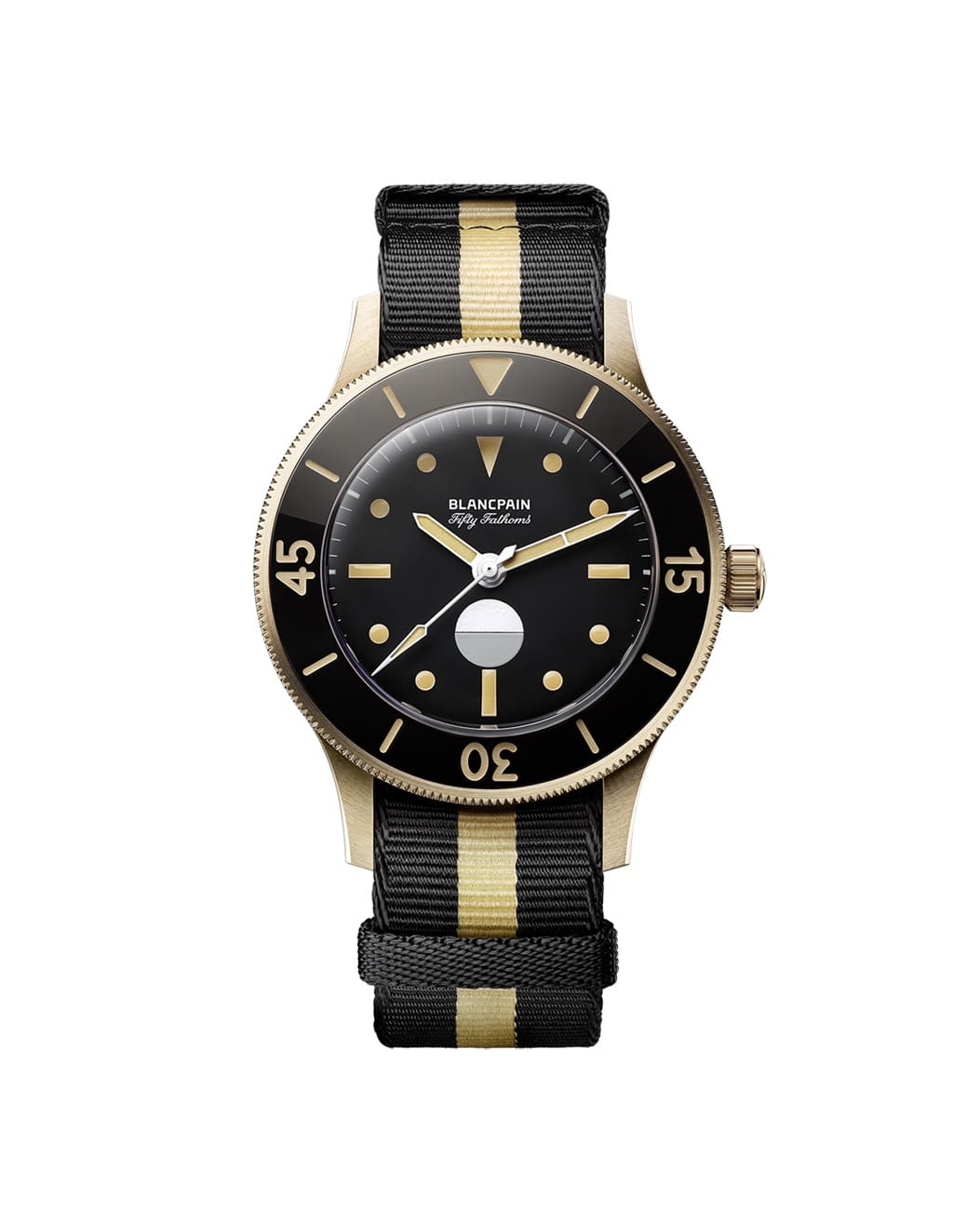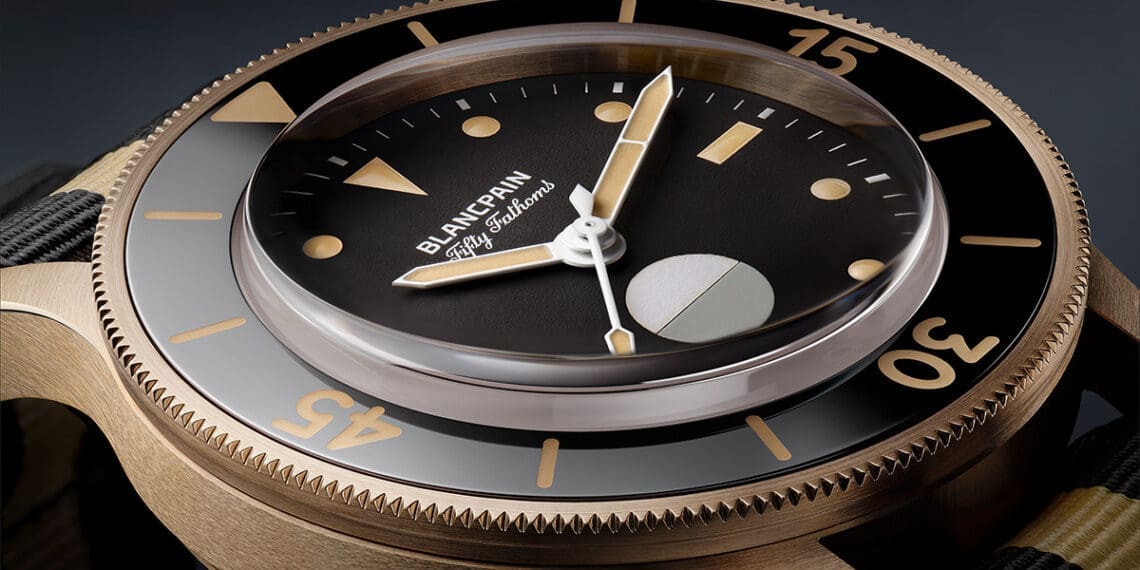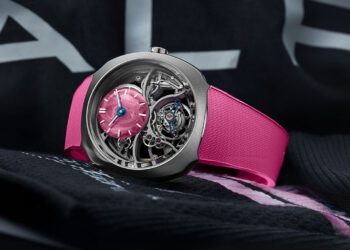In a celebration of horological history and innovation, Swiss luxury watchmaker, Blancpain, this weekend in Cannes unveiled its newest “Fifty Fathoms 70th Anniversary Act 3” watch. This limited-edition timepiece marks the 70th anniversary of the iconic Fifty Fathoms diver’s watch, paying homage to its rich 70-year heritage and legacy. The newest Act 3 is inspired by the MIL-SPEC watch that was used by the armed forces in the 1950’s. The new 41.3mm timepiece is faithful to the original in most aspects, including its trademark moisture indicator, but, of course, with updates.
The third and final “act” of Fifty Fathoms watches that were unveiled this year in celebration of the 70th anniversary of the Fifty Fathoms, the Act 3 is being created in a limited edition of 555 pieces. Intriguingly, it is being made of 9K Bronze Gold and is a timepiece of both the highest form and function. It was unveiled during a diving and snorkeling expedition in Cannes – the city of its conception.
Originally born in 1953, the Fifty Fathoms dive watch was the brainchild of the then co-CEO (along with his aunt Betty) Jean-Jacques Fiechter (who was CEO of the brand from 1950 to 1980). An avid diver, Fiechter was diving in Cannes in the south of France when he unexpectedly ran out air. Obviously, he surfaced safely but with a new and important thought – one that would change the course of Blancpain and dive watches forever.
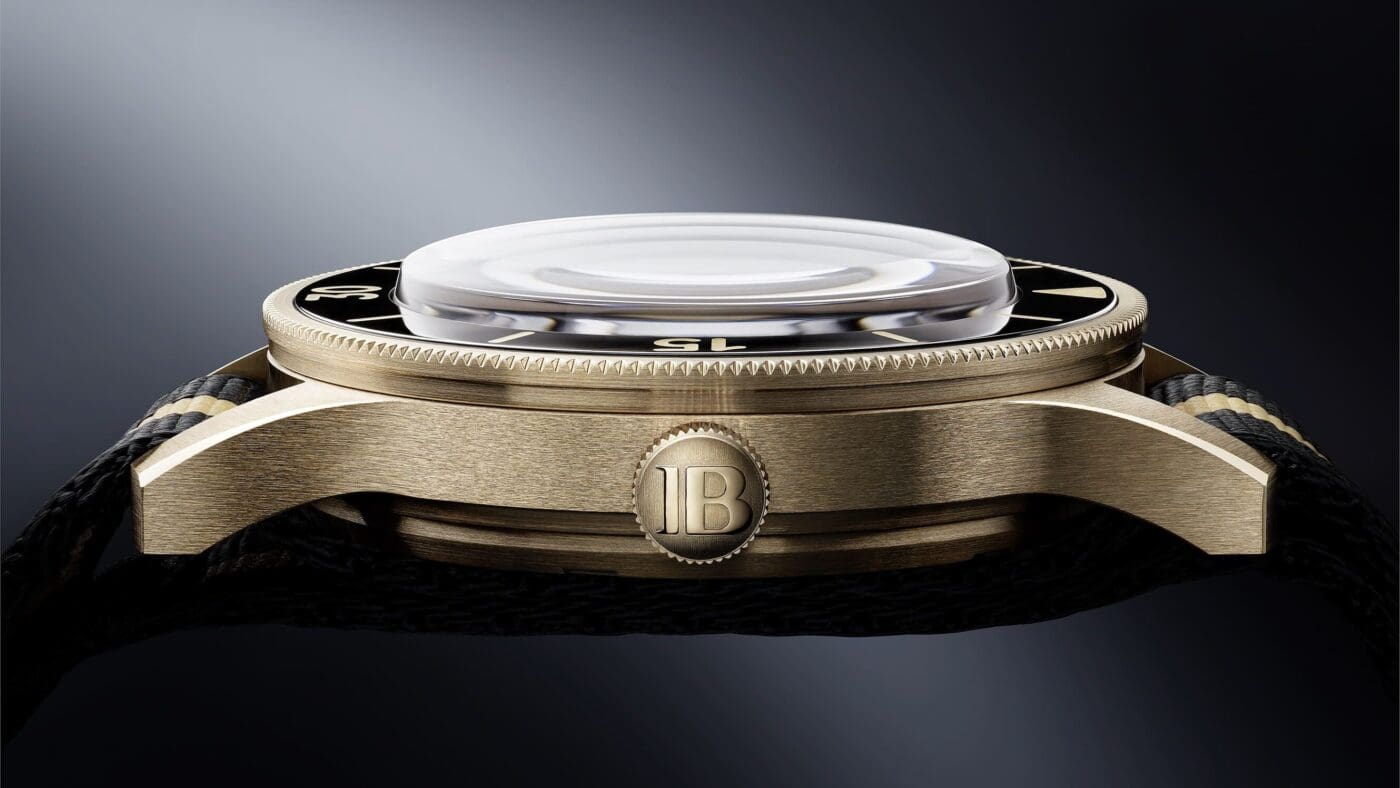
During a festive unveiling and presentation on Sainte-Marguerite Island off the coast of Cannes, Marc A. Hayak, President and CEO of Blancpain, said the location was right for this unveiling for a variety of reasons. “Cannes is the birthplace of the Fifty Fathoms and it was here that recreational diving started. Today we have tens of millions of divers, but those first divers were the pioneers and Mr. Fiechter was one of those discovering this new underwater world. Having almost lost his live during that dive when he ran out of air, he knew a new instrument had to be more than water resistant. That’s when he developed the locking bezel and other key features that make the Fifty Fathoms relevant.”
Fiechter recognized the need for a better dive instrument for scuba divers. He focused on creating the perfect dive watch, with attention paid to function. This was not to be a watch as much as it was to be a diving instrument. His focus was on achieving the utmost water resistance via adding a double-sealed crown, as well as on function and timing — inventing what may well be the most important aspect of that first Fifty Fathoms watch: a patented rotating bezel with a locking mechanism for reading dive time.
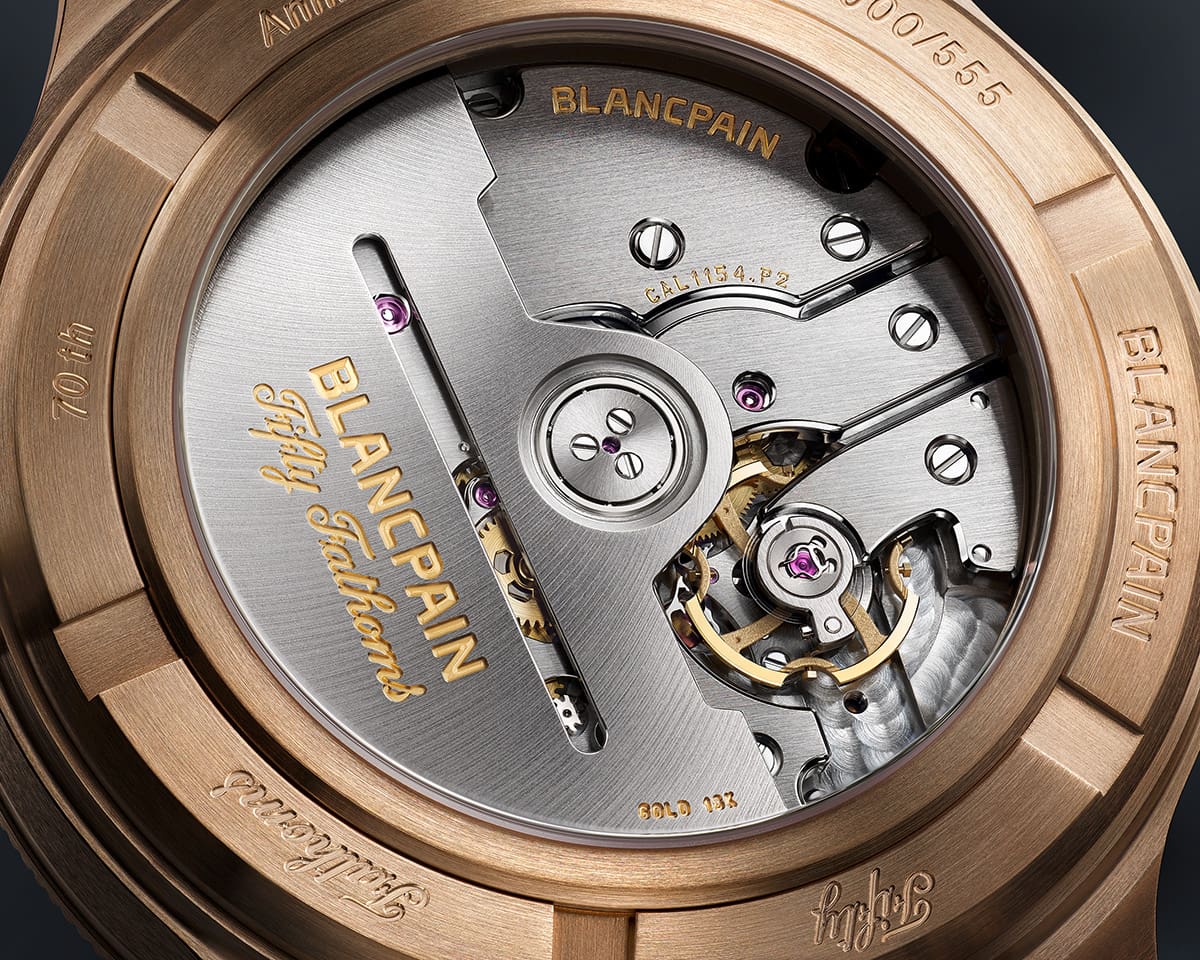
The list goes on and on with what Fiechter accomplished in that first Fifty Fathoms watch but suffice it to say that the 1953 introduction of the Fifty Fathoms watch with self-winding movement marked a new era. In addition to the afore-mentioned innovations, the watch was resistant to magnetism, was water resistant to 10 bar, featured luminescent hour markers for underwater reading, a caseback sealing system and more. The timepiece was incredibly efficient and precise, and enticed the armed forces from France, Germany, the United States and other countries to adopt the watch for their combat divers.
Still, Blancpain continued to evolve the Fifty Fathoms and Fiechter developed a moisture indicator as an additional safety feature to provide divers with an indication that the watch had not been damaged on another dive, which could render it inaccurate or useless. The moisture indicator appeared on the dial of the MIL-SPEC watches in 1957 and was part of the specifications of the US Navy, which regarded this model as the premier watch to meet all of its criteria for underwater missions.
Related Articles
It is that 1957 MIL-Spec watch that was the inspiration for this new Fifty Fathoms 70th Anniversary Act 3 watch. The watch boasts a black dial with vintage-style Super-LumiNova® enhanced moisture indicator and hour markers. Antimagnetic, the watch features the unidirectional rotating bezel with black ceramic insert and Super-LumiNova diving scale. Even the two-tone NATO strap is in the same color code of the original, but it is made from recovered fishing nets to underscore Blancpain’s commitment to the oceans.
Additionally, a new feature is the case material. The original was made of German silver, but the new piece is made of a patented alloy, 9K Bronze Gold. The patented alloy is made using 37.5 percent gold, 50 percent copper (enabling the label “bronze”), as well as silver, palladium and gallium. The alloy has a longer lifespan than traditional bronze and does not oxidize, so it can easily be worn against the skin.
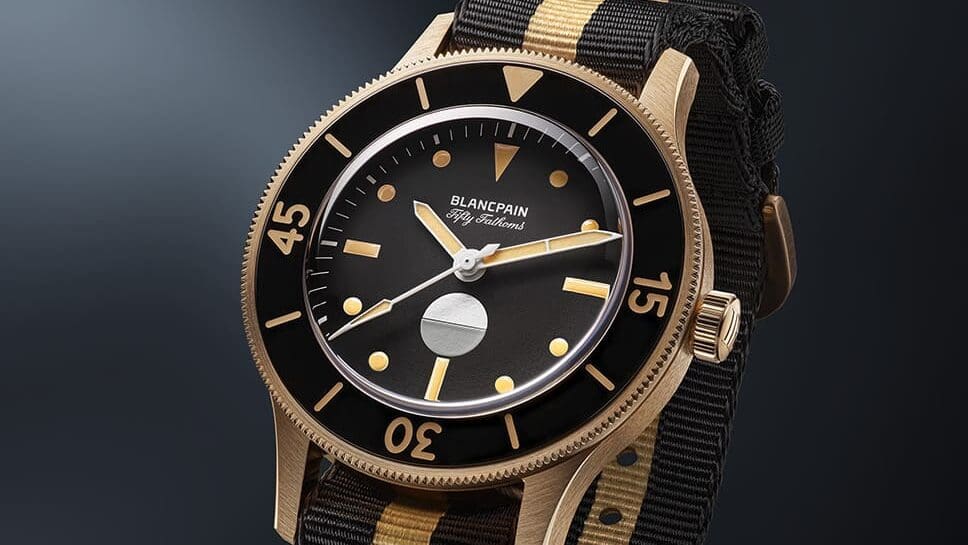
The watch is powered by the brand’s 192-part 1154.P2 movement with twin barrels that equip it with 100 hours of power reserve. A silicon balance-spring ensures the movement’s resistance to magnetism. This is the first time, too, that Blancpain has created a 1000-gauss version of the 1154.P2, which it can accomplish thanks to the use of innovative materials and alloys for the escapement. For this watch, too, the brand can showcase the movement via a transparent sapphire crystal case back thanks to its use of a non-magnetic spiral. The original 1957 version had a metal case back with a soft iron cage to render it anti-magnetic.
The movement is meticulously finished and the enlarged bridges are decorated with a period-inspired motif. The oscillating weight features a geometric shape inspired by the original rotor, with an opening to make it more resistant to shocks, and a snail-shaped finish. The engraved vintage logo further enhances the retro appeal. In short, the changes in the watch are predominantly all thanks to innovative new materials and technology that Blancpain regularly pioneers – along with fastidious attention to design and detail.
As mentioned, just 555 pieces will be made, each sold in a presentation box inspired by historic camera housing, as underwater photography developed around the same time as the dive watch. It retails for $32,000.
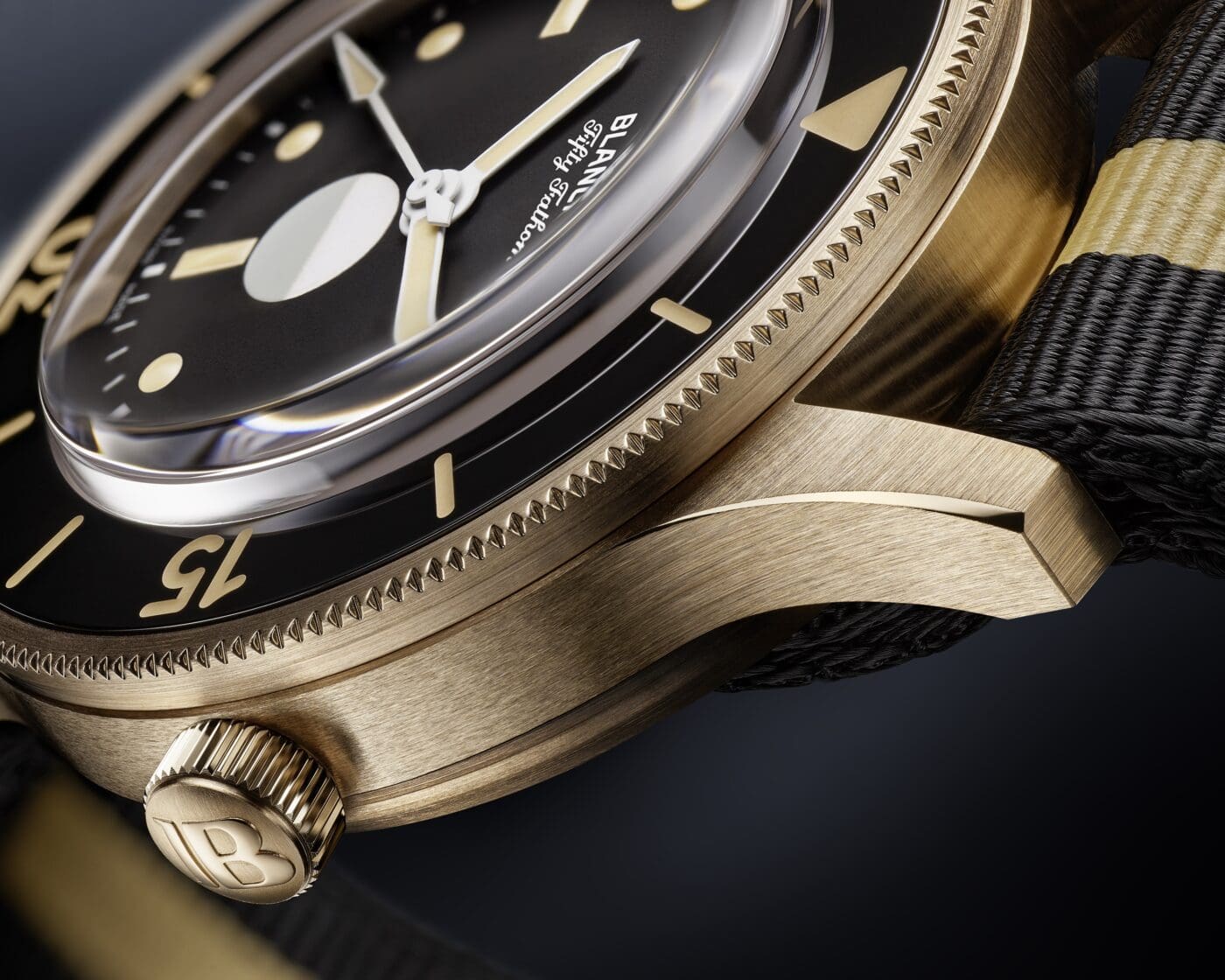
The Act 3 watch is the culmination of the 70th anniversary timepieces and is – like all Blancpain Fifty Fathoms watches – inextricably aligned with the Blancpain Ocean Commitment project. In fact, at the unveiling of the timepiece in Cannes – the birthplace of the Fifty Fathoms concept — this past weekend, Blancpain brought together some of the foremost minds and companies associated with saving our oceans for a panel discussion that not only outlined how important the oceans are to our lives, but also to ensure that there is hope – if we all play a role.
Among the participants: scientist and founder and leader of the Gombessa Expeditions, Laurent Ballesta; Andrew Sharpless, CEO of Oceana, Drew Richardson, CEO of PADI, Oceana and Charles Goddard, The Economist Impact Editorial Director, Marc Hayak, CEO of Blancpain – moderated by diver and founder of The Grey Nato, Jason Heaton. Details on that panel discussion will be forthcoming soon.
According to Hayak, “In continuation of the Fifty Fathoms’ role in the opening up of the underwater world, Blancpain has been supporting those who best raise awareness of ocean issues, and especially those who convey a positive message insisting on the inspiring beauty of what’s intact.”
